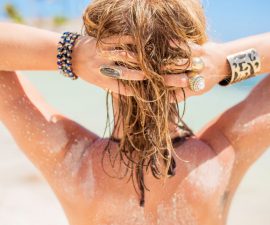When we grow in years, the needs of both the skin and hair change. What’s more, the aging process may even change your hair type. That is why you should suit your hair care to the changing circumstances. How to care for mature hair? Let us share the best tips for hair that turned 40!
Symptoms of hair aging
With age the hair goes gray and dry, plus it grows more slowly and in smaller amounts. The change of the hair color flows from the poorer production of melanin – the natural pigment that gives the hair its unique shade. The individual pace of graying depends on the genes and external factors for example connected with a lifestyle.
As far as dry hair goes, hair loses moisture because the glands produce less sebum due to aging. What causes the hair to lose volume and grow more slowly with age? The body produces less collagen (aka protein of youth) while the hair follicles work more slowly.
When your hair goes thinner and drier, breaks, excessively falls out and lacks shine, it’s a sign you must take a different approach to hair care. This doesn’t mean, though, that your hair care was wrong – the needs of your hair simply changed.
What’s the best antiaging hair care like?
- Antiaging hair products
Make sure that your products feature ingredients like keratin and coenzyme Q10 (stimulate hair growth), peptides, amino acids, collagen hydrolysate, vitamin E and plant extracts (moisturize the scalp, nourish the follicles, repair and boost volume of hair). - The method and frequency of washing
You need to wash your mature hair as often as necessary because oil buildup and other impurities prevent the nutrients from penetrating the hair follicles. The right technique of washing aging hair involves dampening the hair with lukewarm water, spreading a small amount of a shampoo between the palms and applying it to the hair: massage the hair and scalp for around three minutes to boost blood flow making it easier for nutritional ingredients to penetrate the follicles.
Then, you rinse the hair and towel dry, and move on to a conditioner – apply it to the ends first because they need repair the most and spread the product onto the lengths using a comb, avoiding the hair roots and scalp. Finally, rinse the hair using lukewarm water. - Antiaging hair and scalp procedures offered by esthetic medicine
If your at-home hair care seems to fail, you can try esthetic medicine treatments to improve the condition of hair. You can choose between scalp mesotherapy or platelet rich plasma treatment.
The first procedure involves injecting vitamins and minerals suited by the doctor to the patient’s needs into the scalp – they either have a hydrating effect or block hair loss. The other treatment also uses injections yet the substance is different – it’s the patient’s blood plasma which is processed in order to get the biggest number of factors that stimulate hair follicles to work.



